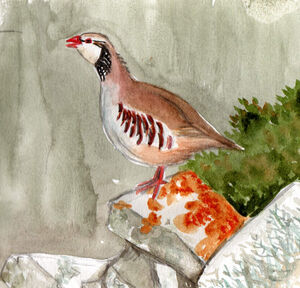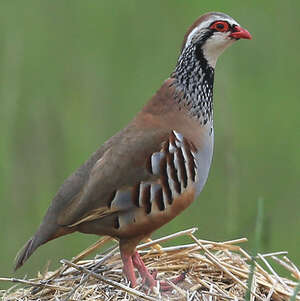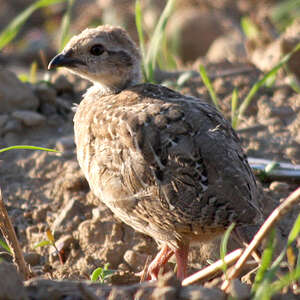Red-legged Partridge
Alectoris rufa - Perdrix rouge
Identification
The Red-legged Partridge is bigger and more colorful than its cousin, the Grey Partridge. From a distance, the adult looks like a large warm brown bird with a particular head. Its four-colored head is indeed remarkable. The beak and the area around the eye is red-coral. The throat and cheeks are white surrounded by black. Two white stripes go from the forehead to the nape above the eyes. They border a soil-colored crown stripe. The neck and upper chest are dotted with black and white. The belly is grayish and the underside is reddish brown. The flanks are clearly vertically barred. The legs are red. The sexes are similar - the male is simply stronger than the female. Its short, sturdy wings allow for a powerful and fast vibrating flight, even though the bird prefers to flee danger by running. The legs are fairly long and strong and are particularly well adapted for walking in open and hilly terrain.
Subspecific information 3 subspecies
- Alectoris rufa rufa (Britain, France, n Italy, Corsica)
- Alectoris rufa hispanica (n and w Iberian Pen.)
- Alectoris rufa intercedens (e and s Iberian Pen.)
Foreign names
- Perdrix rouge,
- Perdiz roja,
- perdiz-vermelha,
- Rothuhn,
- vörös fogoly,
- Rode Patrijs,
- Pernice rossa,
- rödhöna,
- Rødhøne,
- kuropta červená,
- orebice rudá,
- Rødhøne,
- punapyy,
- perdiu roja,
- Sandhæna,
- góropatwa czerwona,
- kalnu irbe,
- španska kotorna,
- Красный кеклик,
- アカアシイワシャコ,
- 红腿石鸡,
- 紅腳石雞,
Voice song and call
Habitat
The Red-legged Partridge is found in dry, open or semi-open, cultivated or uncultivated environments, often on slopes. It can be found in the following habitats: garrigue, shrubby or bushy grasslands, uncultivated slopes, dry meadows, vineyards, abandoned lands, limestone and sandy moors, plantations, linear edges of territory, etc. The Mediterranean climate is particularly suitable for it. It avoids the closed forest environment as well as wet environments.
Behaviour character trait
The Red-legged Partridge is a bird that likes to live in groups. Outside of the breeding period, it can be found in small, timid groups called flocks which can range from 10-15 individuals up to 40 or more birds depending on the weather.
In cold times, the number can reach a hundred. It frequents open environments like moors, garrigue and some meadows which allow the partridge to easily detect and flee danger. When disturbed, it prefers to run for shelter than to fly. In the presence of a raptor, the Red-legged Partridge often just flattens itself to the ground and stays inert. Its plumage, by its colours and patterns, allows it to blend with the low vegetation and be hidden very efficiently. During breeding season, adults pair up and each couple has its own territory. Only the unmarried ones continue to live in flocks.Flight
Dietfeeding habits
The Red-legged Partridge leaves its roost every morning before dawn to go to a water source. It then spends the morning feeding and resting in a sheltered area during the hottest hours of the day.
It feeds mainly on plants, leaves and roots, seeds, and fruits, but also completes its diet with other invertebrates. When raising young, they receive ants from the age of one week, but locusts are also appreciated prey. Due to this particular diet, young birds are affected when insects are missing in humid summers.Reproduction nesting
Couples form at the end of winter, at the beginning of the nesting season. They are usually lasting for multiple years.
After finding a female, the male looks for a good nest location on the ground, under a bush, or in a hedge. He crouches down and then turns around, digging the ground to make a small bowl. Cuddled in it, he uses his beak to pick leaves and twigs and throws them around him to make a ring. Once the nest is accepted by the female, she lays up to 20 eggs which are incubated by the two adults for about 24 days on average. The chicks leave the nest shortly after hatching and feed beside their parents. The adults communicate with them with soft cooing. They show the chicks food by throwing it in front of them or pointing their beaks in their direction. About 10 days after hatching, the youngsters can already fly for a short distance. Nevertheless, they keep growing for almost two months and stay with adult during the whole winter. Sexual maturity is reached the following spring. It can happen that the male has two partners at the same time.Geographic range
The Red-legged Partridge inhabits the Iberian Peninsula, except for the northwest Atlantic coast, two thirds of France (Brittany, Normandy and all the border regions of the north and northeast, as well as the Jura and the Alps which remain unoccupied), a part of northwest Italy, Corsica and the Balearic Islands. It has been introduced in many places such as Great Britain.
Threats - protection
IUCN conservation status
concern
in the Wild
threatened
evaluated
At present, the species is not considered endangered. However, compared to its historic range, it has disappeared from areas such as Brittany, western and southern Switzerland, or Rhineland in Germany. Hunting pressure is a local important factor in the species' demography, for example in Portugal. Habitat fragmentation due to farming or urbanisation also plays a negative role.
Sources of information
- IOC World Bird List (v15.1), Gill, F and D Donsker (Eds). 2025-12-07.
Other sources of interest
 Specification sheet created on
19/07/2023 by Jean François
Specification sheet created on
19/07/2023 by Jean FrançoisTranslation by AI Oiseaux.net
© 1996-2025 Oiseaux.net
- Accipitriformes
- Aegotheliformes
- Anseriformes
- Apodiformes
- Apterygiformes
- Bucerotiformes
- Caprimulgiformes
- Cariamiformes
- Casuariiformes
- Charadriiformes
- Ciconiiformes
- Coliiformes
- Columbiformes
- Coraciiformes
- Cuculiformes
- Eurypygiformes
- Falconiformes
- Galliformes
- Gaviiformes
- Gruiformes
- Leptosomiformes
- Mesitornithiformes
- Musophagiformes
- Nyctibiiformes
- Opisthocomiformes
- Otidiformes
- Passeriformes
- Pelecaniformes
- Phaethontiformes
- Phoenicopteriformes
- Piciformes
- Podargiformes
- Podicipediformes
- Procellariiformes
- Psittaciformes
- Pterocliformes
- Rheiformes
- Sphenisciformes
- Steatornithiformes
- Strigiformes
- Struthioniformes
- Suliformes
- Tinamiformes
- Trogoniformes































